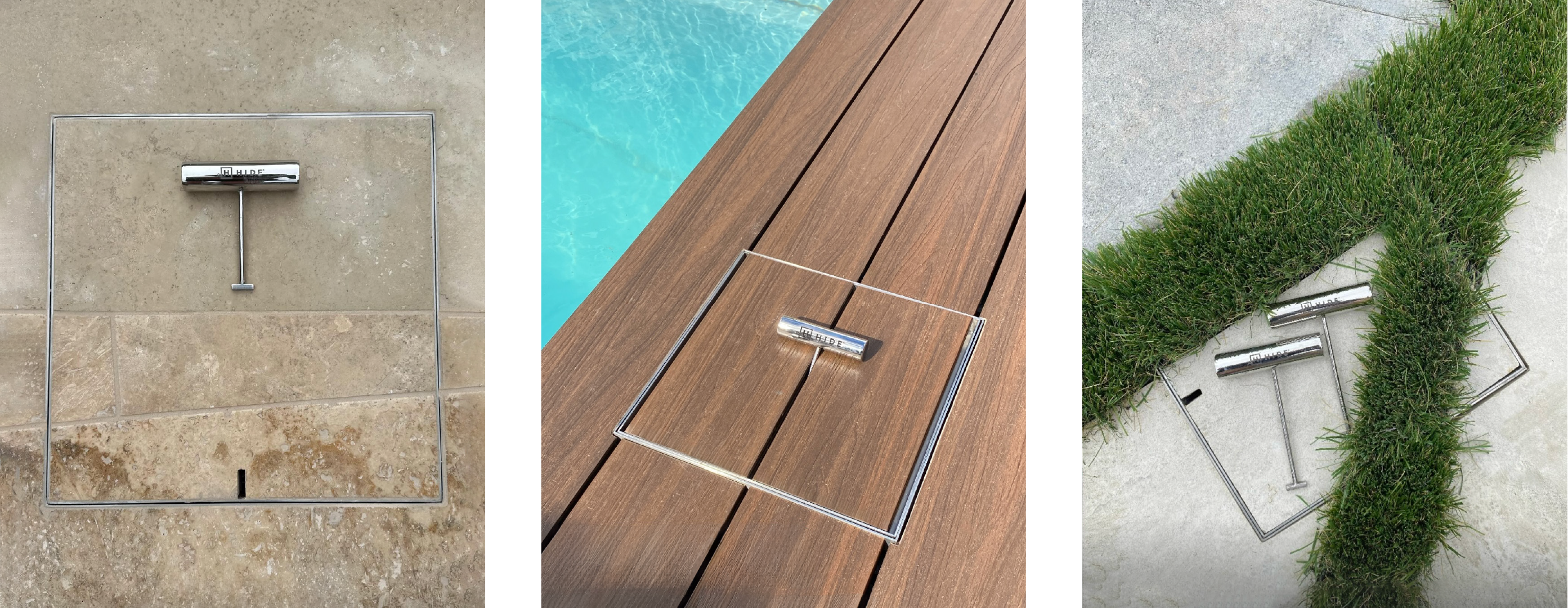Superior properties of 316L stainless steel
Armoured by a self‑healing chromium‑oxide skin, 316 L stainless steel re‑passivates the instant it is scratched, shutting out aggressive pool chlorides while lesser materials discolour and degrade. HIDE therefore urges pool owners to rinse lids regularly and wipe away any early “tea‑stain” film with mild soapy water; those iron‑oxide particles are purely surface debris, but if left in place can leach onto porous stone or grout and may leave a permanent brown shadow.
The same alloy that gleams on super‑yacht railings thrives beside a pool, delivering unrivalled strength, chloride immunity, UV stability and a service life measured in decades. Keep the passive layer clear of salt, avoid acid cleaners that strip it away, and a HIDE 316 L cover will effortlessly outperform polymer alternatives while preserving the beauty of the surrounding stone.
“Don’t take our word—or a plastic maker’s sales pitch—for it. We dug into the data, reviewing authoritative studies and global experts in stainless‑steel fabrication. Read on to see why HIDE chose 316 L stainless for its skimmer lids and exterior inlay covers—and why that decision delivers the most durable, elegant solution on the market.”
1: Why 316L Stainless Steel Will Not “Rust” at the Pool Edge
1.1 Self‑healing passive film
Stainless steels owe their corrosion resistance to a thin, invisible chromium‑oxide barrier that reforms immediately in air or water and seals the metal from oxygen attack (Nickel Institute, Nickel Institute).
1.2 Molybdenum = chloride shield
Adding ~2 % Mo in 316/316L lifts the alloy’s pitting‑resistance number, giving far better defence against pool‑water chlorides than 304 or plastics (SpringerLink, imoa.info).
1.3 Low‑carbon “L” grade
The “L” means ≤0.03 % C, preventing chromium‑carbide precipitation during welding and keeping that passive film intact for the life‑span of the lid (ASSDA).
2: Routine Care—Clean Early, Clean Light
HIDE’s care sheet mirrors global best practice: rinse lids with fresh water and a mild detergent, wiping in the polishing grain, then dry (Exeter Trade Aluminium, astrastreetfurniture.com.au).
2.1 Tea staining is cosmetic debris
Tea staining is a brown film caused by salts or dust trapped on the surface; it does not attack the metal’s integrity (ASSDA).
2.2 Remove it promptly
If iron‑oxide particles stay in place, stormwater can wash them onto adjacent porous tiles or grout, leaving permanent brown ghosting (Natural Stone & Timber). ASSDA and leading fabricators advise wiping stains away “within months of appearance” to stop the problem before it migrates (Austral Wright Metals).
Quick clean recipe (no acids!):
-
Hose off salt.
-
Soft cloth + pH-neutral soap.
-
Stubborn film? Use a non‑chloride stainless cleanser or baking‑soda paste, rinse well, and dry.
2.3 Natural rain helps
Designing covers flush with deck levels lets rainfall rinse the lid, which ASSDA notes halves tea‑stain risk (ASSDA).
3: Never Use Acid Near the Lid
Brick‑cleaning muriatic acid strips the passive film and etches stainless; Australian and BlueScope guidance show splash zones corroding in days (cdn.dcs.bluescope.com.au). Any brown streaks after an acid wash are misuse, not a material failure.
4: Polymer Lids
Pool chemicals are unforgiving on plastics. Oxidising sanitisers (chlorine and sodium‑hypochlorite), low‑pH acid washes and relentless UV all attack polymer chains, bleaching colour, stripping UV stabilisers, embrittling the material and setting up stress‑crack failure. The result is the familiar story of yellowed, brittle lids and bubble‑covers that flake into the water after only a handful of seasons—problems 316 L stainless simply avoids.
Read the full report here:
5: Engineering Edge over Polymer Lids
| Factor | 316L Stainless | Pool‑grade PP/ABS | Source |
|---|---|---|---|
| Ultimate tensile strength | ~530 MPa | ≈30 MPa | (Make It From) |
| Thermal expansion 20‑40 °C | 16 µm m‑1 K‑1 | 72‑90 µm m‑1 K‑1 | (Engineering ToolBox) |
| UV/oxidiser resistance | Passive film unaffected | UV‑induced cracking, chlorine stress‑cracking | (ScienceDirect, SCIRP) |
| Service life | Marine hardware >30 yrs | 5‑10 yrs before embrittlement | (just4marine.com) |
| Recyclability | >90 % recovered and reused | Difficult mixed‑plastic waste | (Circular Economy Platform) |
6: Responding to “Rusted Lid” Photos
-
Test the mark: wipe with soapy water; if it lifts, it was tea‑stain, not rust.
-
Look for acid drip lines: sharp, etched streaks betray improper brick‑acid cleaning.
- Care for your stainless steel today, and enjoy flawless performance for decades.
